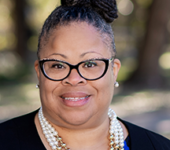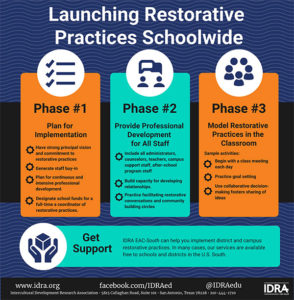• Paula N. Johnson, Ph.D. • IDRA Newsletter • September 2021 •
 Public schools are increasingly adopting a restorative approach for building community and relationships. Restorative justice practices involve developing welcoming learning environments that are inclusive of all students and foster relationships within the school community. Studies show that using restorative justice practices positively impacts student behavior (Johnson, 2019).
Public schools are increasingly adopting a restorative approach for building community and relationships. Restorative justice practices involve developing welcoming learning environments that are inclusive of all students and foster relationships within the school community. Studies show that using restorative justice practices positively impacts student behavior (Johnson, 2019).
Successful implementation relies heavily on understanding that behavior is not the primary focus. IDRA encourages schools and districts to implement restorative justice as a means of addressing issues of equity schoolwide.
Here, I provide a guided tour of the implementation process and share expectations, challenges and benchmarks for the first two to three years.
Plan for Implementation
For all that restorative justice has to offer, it is important to assure that your school is prepared for the endeavor. The first step is to assess the readiness of your campus for a culture shift. The Denver School-Based Restorative Practices Partnership identifies four key readiness components: “strong principal vision and commitment to restorative practices, explicit efforts to generate staff buy-in, continuous and intensive professional development opportunities, and allocation of school funds for a full-time a coordinator of restorative practices at the site” (Anyon, 2017).
Public schools are increasingly adopting a restorative approach for building community and relationships.
Many times, superintendents, principals, teachers and staff need to reframe their thinking about what it means to be restorative in order to fully embrace a restorative mindset.
The first year will set the tone for implementation and requires a willingness to grow as a community of practitioners through the process. Another proactive strategy is to involve students, parents and caregivers in the initial phases of the preparation process (Johnson, 2019).
Before embarking on a professional development model, the restorative practices team needs to consider a few key elements, including a timeline for professional development, how to incorporate restorative practices into the school day, and ways for teachers and staff to practice community-building with students on a regular basis.
 Provide Professional Development for All Staff
Provide Professional Development for All Staff
It is essential for school leaders to give teachers and staff comprehensive professional development. Schools should schedule introductory professional development for teachers and staff early in the school year to maximize implementation of proactive strategies schoolwide (Yusem, et al., 2016). The goal is to build capacity for developing relationships.
Professional development should foster strong interpersonal connections when used consistently and with the intention of transforming the climate and culture of an entire school (Yusem, et al., 2016; Anyon, 2016).
Initial restorative practices training involves learning to facilitate restorative conversations and community building circles for schoolwide use with all students. This training, along with coaching, should include all administrators, counselors, teachers, campus support staff, after-school program staff and any school security officers (Yusem, et al., 2016).
Students model the behavior of the adults surrounding them (Anyon, 2016). That means all adult staff should contribute to developing restorative language and establishing a restorative campus culture. Restorative conversations then become the norm for communication with fellow teachers, students and families.
Model Restorative Practices in the Classroom
Once the entire staff begin to receive training in restorative practices strategies for building relationships, it is just as important to plan for engagement. Below are several practical applications of restorative practices that teachers can use on a daily basis.
- Begin the day with a class meeting. This helps you build relationships with students and helps you gain an idea of their social and emotional mindsets. These brief conversations help take the pulse of the room and provide the instructional focus for the day (Yusem, et al.).
- Practice goal setting. This is another restorative practice strategy teachers can use to help students identify areas of success and opportunities for improvement, both academically and socially. Individual conferencing throughout the week enables students to set and review goals and action steps. Over time, students will develop reflection skills and learn to assess and refocus as needed.
- Use collaborative decision-making to foster sharing of ideas where all voices contribute to the process. This technique is useful when selecting the theme for a project or the location of the next field trip. Depending on the circumstances, the final decision may rest with the group through voting. Other times, the teacher has the final say after considering input from the class.
Understand that each year of implementation will have its challenges. Changes in students and staff can make you feel like you’ve taken a step back. Keep going! Developing a restorative community takes time and patience. Acknowledge small wins along the way.
Get Support
The IDRA EAC-South places equity at the forefront of the restorative justice practices process by integrating culturally sustaining pedagogy into our content to inform the development of schoolwide equitable and restorative practices. This includes a comprehensive professional development model with elements for diversity, equity and inclusion, growth mindsets, and increasing student and family engagement.
The primary objective of restorative practices training facilitated by the IDRA EAC-South is that educators and staff at all levels adopt the following practices that promote caring communities for all parties involved.
- Understand harm and develop empathy,
- Listen and respond to all needs,
- Encourage accountability and responsibility,
- Recognize the community as valuable, contributing members,
- Create caring climates to support healthy communities, and
- Change any systemic practices that contribute to harmful environments.
Is your campus or district ready to begin building community through restorative practices? On request, the IDRA EAC-South will co-plan and facilitate district and campus restorative practices equity training with the implementation team. Campus planning follows with tailored models of implementation according to the needs of each campus. In-person and virtual coaching and mentoring provide support for facilitators through the initial stages of training and implementation.
Our facilitators also collaborate with campus and district teams to plan and deliver turnaround training and support campus implementation as needed. In many cases, these services are provided free through funding from the U.S. Department of Education, contingent upon continued support. The IDRA EAC-South serves states and school districts in federal Region II: Alabama, Arkansas, District of Columbia, Florida, Georgia, Louisiana, Mississippi, North Carolina, South Carolina, Tennessee, Texas and Virginia.
For more information on our restorative justice practices campus team training and coaching support services visit https://www.idra.org/services.
Resources
Anyon, Y. (2016). Taking Restorative Practices School-Wide: Insights from Three Schools in Denver. Denver: Denver School-Based Restorative Practices Partnership.
Denver School-Based Restorative Practices Partnership. (2017). School-wide Restorative Practices: Step by Step. Denver.
Johnson, P. (2019). Restorative Practices – Informal and Formal Processes for Addressing Behavior. IDRA Newsletter.
Yusem, D., Curtis, D., Johnson, K., McClung, B., Davis, F., Kumar, S., & Hysten, F. (2016). Oakland Unified School District Restorative Justice Implementation Guide: A Whole School Approach. Oakland, Calif.: Oakland Unified School District.
Paula N. Johnson, Ph.D., is an IDRA senior education associate and director of the IDRA EAC-South. Comments and questions may be directed to her via email at paula.johnson@idra.org.
[©2021, IDRA. This article originally appeared in the September 2021 IDRA Newsletter by the Intercultural Development Research Association. Permission to reproduce this article is granted provided the article is reprinted in its entirety and proper credit is given to IDRA and the author.]



